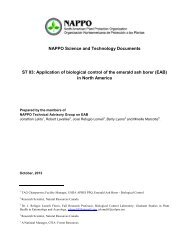NAPPO Regional Standards for Phytosanitary Measures (RSPM)
NAPPO Regional Standards for Phytosanitary Measures (RSPM)
NAPPO Regional Standards for Phytosanitary Measures (RSPM)
You also want an ePaper? Increase the reach of your titles
YUMPU automatically turns print PDFs into web optimized ePapers that Google loves.
levels in commercial, non-commercial, or wild hosts in the proposed ALPP. It ispreferable that documentation be provided <strong>for</strong> as long as possible prior to the recognitionof the ALPP.1.3.3 The NPPO should establish a monitoring program to assure that the control measures areproperly applied.1.4 Other Technical In<strong>for</strong>mation1.4.1 Establish an official list of the target pest(s) and other quarantine pests that may bepresent in the proposed ALPP.1.4.2 Retain historical records of detection, population dynamics, and survey activities <strong>for</strong> thedesignated target pest(s) and other quarantine pests in the proposed ALPP.1.4.3 If detections of the target pest(s) have occurred in the proposed ALPP, document thephytosanitary actions taken and the results of those actions.1.4.4 Retain records of the commercial production of host crops in the area, an estimate of noncommercialproduction, and the host plants in proximity to commercial production areas.1.4.5 Document phytosanitary measures taken, and the success of these measures, to preventspread of the target pest(s) into the ALPP.2. Maintenance of an Area of Low Pest PrevalenceAn area of low pest prevalence is maintained by the continued application of phytosanitaryprocedures directed at the target pest(s). The status of the area is confirmed by monitoringsurveys in the low prevalence area and buffer zone during specific periods of time and at alevel of sensitivity that will detect target pests, if present.2.1 Control <strong>Measures</strong>2.1.1 Apply control measures to maintain the target pest(s) populations below threshold levelsin commercial, non-commercial, or wild hosts in the proposed ALPP. The controlmeasures should be relevant to the biology and life cycle of the target pest(s).2.1.2 Document control measures used to maintain the target pest(s) populations belowthreshold levels in commercial, non-commercial, or wild hosts in the proposed ALPP.2.1.3 The NPPO should maintain a monitoring program to assure that the control measures areproperly applied.2.2. Surveillance activities2.2.1. Surveillance protocols (e.g., trapping) in the ALPP are dependent upon the biology of thetarget pest(s) and the assessed level of risk of entry <strong>for</strong> the target pest(s) and otherquarantine pests. The duration of surveillance should extend beyond the activity period ofthe target pest(s). The preseason and postseason surveillance periods and the frequencyof activities are dependent upon the target species and the prevailing climatic conditions.These parameters should be detailed in the bilateral workplan.2.2.2. The NPPO should maintain a quality control program <strong>for</strong> the survey to confirm anddocument that all protocols are met. The key elements of the quality control programwould include:• Validation of detection techniques.<strong>RSPM</strong> No. 20Guidelines <strong>for</strong> the Establishment, Maintenance and Verification of an Area of Low Pest Prevalence <strong>for</strong> Insects Page 10
















